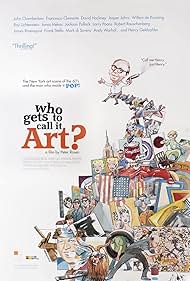Metropolitan Museum of Art curator Henry Geldzahler reflects on the 1960s pop art scene in New York.Metropolitan Museum of Art curator Henry Geldzahler reflects on the 1960s pop art scene in New York.Metropolitan Museum of Art curator Henry Geldzahler reflects on the 1960s pop art scene in New York.
Photos
Richard Bellamy
- Self
- (archive footage)
Leo Castelli
- Self
- (archive footage)
Salvador Dalí
- Self
- (archive footage)
Willem de Kooning
- Self
- (archive footage)
Helen Frankenthaler
- Self
- (archive footage)
Henry Geldzahler
- Self
- (archive footage)
Clement Greenberg
- Self
- (archive footage)
Storyline
Did you know
- ConnectionsFeatures End of the Art World (1971)
Featured review
This little gem may represent the last gasp of healthy symbiotic intersection between pure art and the world of commerce, a centuries old tradition that died with the rise of corporate supremacy in the latter half of the 20th century.
Henry Geldzahler is lovingly memorialized by world class artists Frank Stella, Jasper Johns, David Hockney and others. Born into a wealthy family of Belgian diamond merchants, Geldzahler transcended his illustrious materialistic roots to inject himself as a potent and active force in the world of modern art. A maverick assistant curator at New York's Metropolitan Museum, Geldzahler was prescient enough to recognize the future of art and instrumental in establishing America's modern artists as a force to be reckoned with.
Geldzahler stands primarily as an example of someone who was born into incredible privilege, yet used his social advantage as but a starting point for a career that influenced American culture at the highest intellectual level.
Testimony to his importance lies in the multitude of flattering portraits of Geldzahler completed by the greatest American artists of his era, many of whom appear in this documentary to lend oral tribute to him as well.
While Geldzahler's story makes this a must see for anyone interested in the arts (particularly Modern American art) or in the depiction of a brilliantly realized upper class life, the most precious clips are those showing Geldzahler's friends at their best: Andy Warhol's brief but trenchant observations are well worth sitting through this on their own, and Frank Stella's comments brilliantly illuminate the state of the arts in 50s and 60s America, and Geldzahler's place in that scene.
Anyone interested in the arts will appreciate Geldzahler's incredible ability to recognize art at its inception, years before the slugs of Middle American society were able to grasp its significance, and only with the aid of forward-thinking guides like Geldzahler to explain it.
Geldzahler was that rarest of species: a person who could have easily coasted through life on the coat-tails of his ancestors, fat and happy on the dregs of their accomplishments, yet rose beyond their limitations to affect the course of art history by recognizing and supporting worthy and brilliant artists who may otherwise have been overlooked, with no social or political agenda to affect his artistic judgments.
Geldzahler represents the last of an extinct breed. Uncorrupted and uncompromised, he intersected with the creative community in a way that is impossible even for the most powerful of today's media moguls, who ultimately must answer to their brainless corporate uberlords.
Art lovers should watch this, and appreciate that there was a time when art for art's sake had its champions, and wealthy educated patrons were as pure of heart as the artists they championed.
Artists will watch it, and wish they had been born when Geldzahler still walked the earth.
Henry Geldzahler is lovingly memorialized by world class artists Frank Stella, Jasper Johns, David Hockney and others. Born into a wealthy family of Belgian diamond merchants, Geldzahler transcended his illustrious materialistic roots to inject himself as a potent and active force in the world of modern art. A maverick assistant curator at New York's Metropolitan Museum, Geldzahler was prescient enough to recognize the future of art and instrumental in establishing America's modern artists as a force to be reckoned with.
Geldzahler stands primarily as an example of someone who was born into incredible privilege, yet used his social advantage as but a starting point for a career that influenced American culture at the highest intellectual level.
Testimony to his importance lies in the multitude of flattering portraits of Geldzahler completed by the greatest American artists of his era, many of whom appear in this documentary to lend oral tribute to him as well.
While Geldzahler's story makes this a must see for anyone interested in the arts (particularly Modern American art) or in the depiction of a brilliantly realized upper class life, the most precious clips are those showing Geldzahler's friends at their best: Andy Warhol's brief but trenchant observations are well worth sitting through this on their own, and Frank Stella's comments brilliantly illuminate the state of the arts in 50s and 60s America, and Geldzahler's place in that scene.
Anyone interested in the arts will appreciate Geldzahler's incredible ability to recognize art at its inception, years before the slugs of Middle American society were able to grasp its significance, and only with the aid of forward-thinking guides like Geldzahler to explain it.
Geldzahler was that rarest of species: a person who could have easily coasted through life on the coat-tails of his ancestors, fat and happy on the dregs of their accomplishments, yet rose beyond their limitations to affect the course of art history by recognizing and supporting worthy and brilliant artists who may otherwise have been overlooked, with no social or political agenda to affect his artistic judgments.
Geldzahler represents the last of an extinct breed. Uncorrupted and uncompromised, he intersected with the creative community in a way that is impossible even for the most powerful of today's media moguls, who ultimately must answer to their brainless corporate uberlords.
Art lovers should watch this, and appreciate that there was a time when art for art's sake had its champions, and wealthy educated patrons were as pure of heart as the artists they championed.
Artists will watch it, and wish they had been born when Geldzahler still walked the earth.
Details
Box office
- Gross US & Canada
- $27,344
- Opening weekend US & Canada
- $7,520
- Feb 5, 2006
- Gross worldwide
- $27,344
- Runtime1 hour 18 minutes
- Color
Contribute to this page
Suggest an edit or add missing content

Top Gap
By what name was Who Gets to Call It Art? (2006) officially released in Canada in English?
Answer











